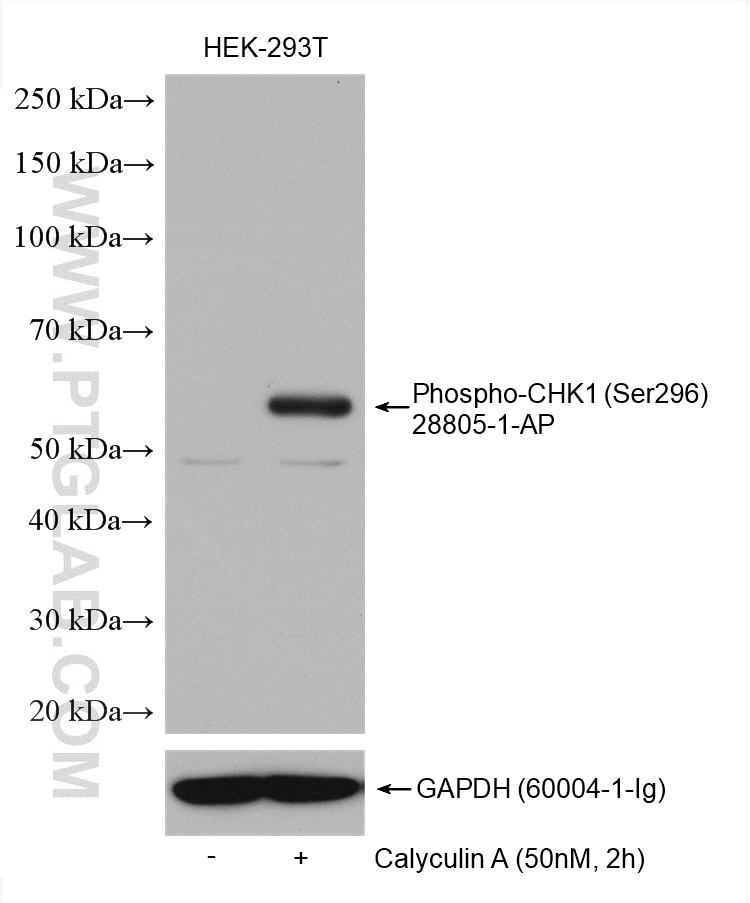Anticorps Polyclonal de lapin anti-Phospho-Chk1 (Ser296)
Phospho-Chk1 (Ser296) Polyclonal Antibody for WB, ELISA
Hôte / Isotype
Lapin / IgG
Réactivité testée
Humain, rat, souris
Applications
WB, ELISA
Conjugaison
Non conjugué
N° de cat : 28805-1-AP
Synonymes
Galerie de données de validation
Applications testées
| Résultats positifs en WB | cellules HEK-293T traitées à la calyculine A, |
Dilution recommandée
| Application | Dilution |
|---|---|
| Western Blot (WB) | WB : 1:1000-1:8000 |
| It is recommended that this reagent should be titrated in each testing system to obtain optimal results. | |
| Sample-dependent, check data in validation data gallery | |
Applications publiées
| WB | See 8 publications below |
Informations sur le produit
28805-1-AP cible Phospho-Chk1 (Ser296) dans les applications de WB, ELISA et montre une réactivité avec des échantillons Humain, rat, souris
| Réactivité | Humain, rat, souris |
| Réactivité citée | Humain, souris |
| Hôte / Isotype | Lapin / IgG |
| Clonalité | Polyclonal |
| Type | Anticorps |
| Immunogène | Peptide |
| Nom complet | CHK1 checkpoint homolog (S. pombe) |
| Masse moléculaire calculée | 54 kDa |
| Poids moléculaire observé | 55 kDa |
| Numéro d’acquisition GenBank | BC004202 |
| Symbole du gène | Chk1 |
| Identification du gène (NCBI) | 1111 |
| Conjugaison | Non conjugué |
| Forme | Liquide |
| Méthode de purification | Purification par affinité contre l'antigène |
| Tampon de stockage | PBS with 0.02% sodium azide and 50% glycerol |
| Conditions de stockage | Stocker à -20°C. Stable pendant un an après l'expédition. L'aliquotage n'est pas nécessaire pour le stockage à -20oC Les 20ul contiennent 0,1% de BSA. |
Informations générales
In response to DNA damage, mammalian cells prevent cell cycle progression through the control of critical cell cycle regulators. CHK1 (synonym: CHEK1), a homolog of the Schizosaccharomyces pombe Chk1 protein kinase, is required for the DNA damage checkpoint. Human Chk1 protein is modified in response to DNA damage. In vitro Chk1 binds to and phosphorylate the dual-specificity protein phosphatases Cdc25A, Cdc25B, and Cdc25C, which control cell cycle transitions by dephosphorylating cyclin-dependent kinases. CHK1 can be autophosphorylated (PMID:22941630) and ubiquitinated (PMID:19276361). Activation of Chk1 involves phosphorylation at Ser317 and Ser345 by ATM/ATR, followed by autophosphorylation of Ser296. Activation occurs in response to blocked DNA replication and certain forms of genotoxic stress.
Protocole
| Product Specific Protocols | |
|---|---|
| WB protocol for Phospho-Chk1 (Ser296) antibody 28805-1-AP | Download protocol |
| Standard Protocols | |
|---|---|
| Click here to view our Standard Protocols |
Publications
| Species | Application | Title |
|---|---|---|
Arch Toxicol SIRT3-dependent mitochondrial redox homeostasis mitigates CHK1 inhibition combined with gemcitabine treatment induced cardiotoxicity in hiPSC-CMs and mice | ||
Cell Prolif eIF3a-PPP2R5A-mediated ATM/ATR dephosphorylation is essential for irinotecan-induced DNA damage response. | ||
Research (Wash D C) Nanoengineered Gallium Ion Incorporated Formulation for Safe and Efficient Reversal of PARP Inhibition and Platinum Resistance in Ovarian Cancer | ||
Cell Death Discov Tert promotes cardiac regenerative repair after MI through alleviating ROS-induced DNA damage response in cardiomyocyte | ||
J Agric Food Chem Kaempferol Induces DNA Damage in Colorectal Cancer Cells by Regulating the MiR-195/miR-497-PFKFB4-Mediated Nonoxidative Pentose Phosphate Pathway |


